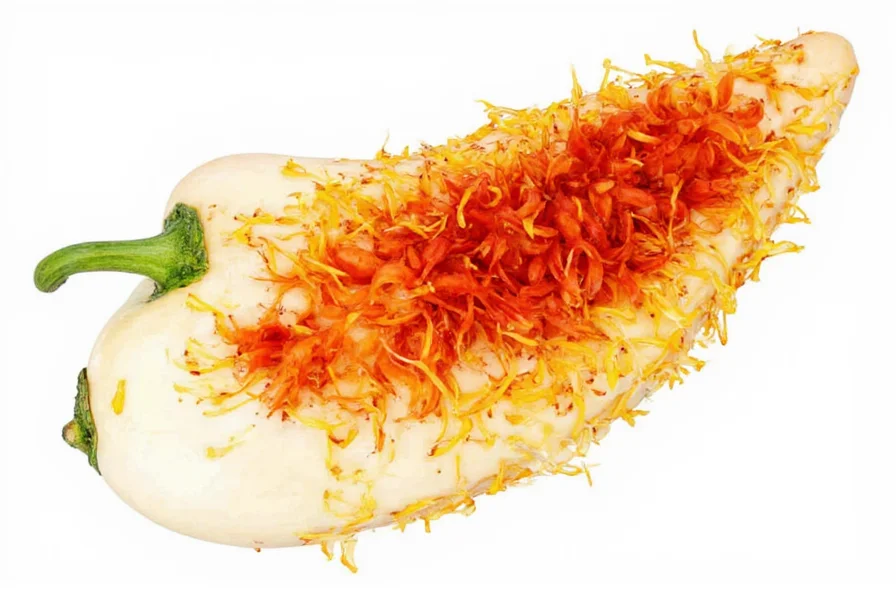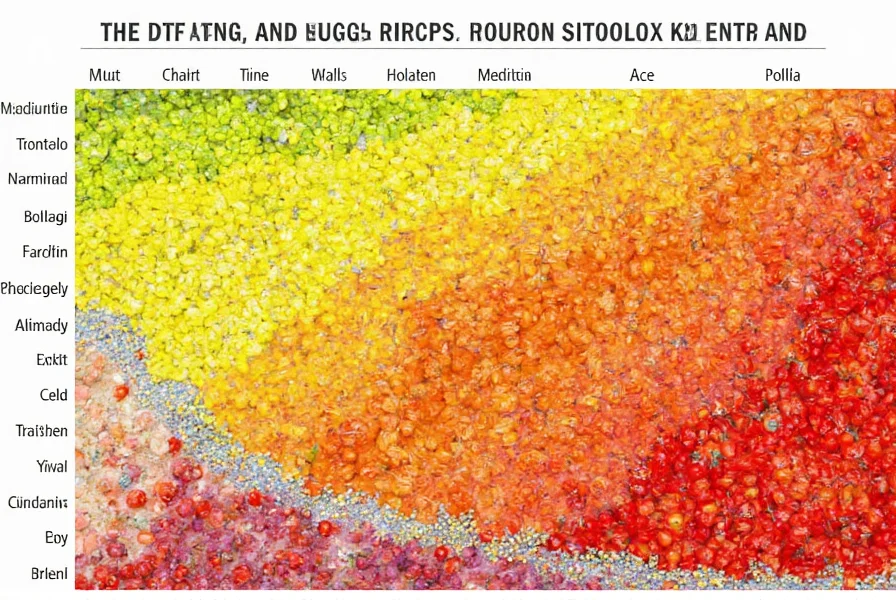Understanding pepper heat is essential for both culinary success and safety. The Scoville scale, developed by pharmacist Wilbur Scoville in 1912, remains the standard measurement for capsaicin concentration—the compound responsible for a pepper's heat. Modern testing uses high-performance liquid chromatography for precise measurements, but the Scoville scale remains the common reference.
How the Scoville Scale Works
The Scoville scale measures heat in Scoville Heat Units (SHU), representing how much sugar water is needed to dilute the capsaicin until it's no longer detectable. Originally determined through human taste testing, today's measurements use scientific methods for accuracy. Each pepper variety has a heat range rather than a single value due to growing conditions, soil composition, and climate factors.
Comprehensive Hot Pepper Chart
Below is a detailed reference showing common peppers arranged by heat intensity. This scoville scale hot pepper chart includes both popular varieties and extremely hot options for reference.
| Pepper Variety | Scoville Heat Units (SHU) | Flavor Profile | Common Culinary Uses |
|---|---|---|---|
| Bell Pepper | 0 SHU | Sweet, crisp, vegetal | Salads, stuffed peppers, stir-fries |
| Pepperoncini | 100-500 SHU | Mildly tangy, slightly sweet | Pickling, Greek salads, sandwiches |
| Jalapeño | 2,500-8,000 SHU | Grassy, bright, medium heat | Salsas, nachos, poppers, pickled |
| Serrano | 10,000-23,000 SHU | Sharp, bright, clean heat | Pico de gallo, hot sauces, guacamole |
| Habanero | 100,000-350,000 SHU | Fruity, floral, intense heat | Caribbean sauces, hot sauces, marinades |
| Ghost Pepper (Bhut Jolokia) | 800,000-1,041,427 SHU | Smoky, sweet, then extremely hot | Extreme hot sauces, competitive eating |
| Carolina Reaper | 1,400,000-2,200,000 SHU | Fruity upfront, then searing heat | Specialty hot sauces, dare challenges |
Understanding Flavor Beyond Heat
A complete hot pepper varieties comparison chart must include flavor characteristics, not just heat measurements. Many peppers offer complex flavor profiles that significantly impact culinary applications. For example, habaneros provide tropical fruit notes that complement mango salsas, while chipotles deliver smoky depth ideal for barbecue sauces.
When selecting peppers for recipes, consider both the heat level and flavor profile. A comprehensive pepper heat chart should help you understand that:
- Mild peppers (0-5,000 SHU) often have sweet, vegetal flavors ideal for fresh applications
- Medium heat peppers (5,000-30,000 SHU) typically offer grassy or bright notes that enhance salsas
- Hot peppers (30,000-100,000 SHU) frequently have floral or citrus undertones
- Extreme heat peppers (100,000+ SHU) often feature surprising fruitiness before the intense burn
Practical Applications of the Hot Pepper Chart
Knowing how to read a hot pepper chart transforms your cooking experience. Professional chefs and home cooks alike use these references to:
- Substitute peppers when specific varieties aren't available
- Balance heat levels for different tolerance preferences
- Create layered heat experiences in complex dishes
- Develop signature hot sauces with predictable heat profiles
- Educate customers about spice levels on restaurant menus
When substituting peppers, remember that heat concentration varies within the same plant—peppers from the top of the plant tend to be hotter than those at the bottom. Additionally, stress during growth (like drought conditions) can increase capsaicin production, making peppers hotter than typical range.
Safety Considerations for Handling Hot Peppers
Working with extremely hot peppers requires proper precautions. Capsaicin can cause severe irritation to skin and eyes. When handling peppers above 50,000 SHU:
- Wear food-safe gloves during preparation
- Avoid touching your face, especially eyes
- Wash hands thoroughly with soap after handling
- Use separate cutting boards for hot peppers
- Consider using eye protection when working with super-hots
If capsaicin exposure occurs, dairy products like milk or yogurt provide relief better than water, which spreads the oil. For severe reactions, seek medical attention immediately.
Common Misunderstandings About Pepper Heat
Several misconceptions persist about pepper heat that a comprehensive hot pepper chart can help clarify:
- Seeds aren't the hottest part—while seeds carry some capsaicin, the highest concentration is in the white pith (placenta) inside the pepper
- Color doesn't determine heat—many peppers change color as they ripen but heat levels remain relatively consistent
- Heat perception varies—individual tolerance affects how heat registers, making standardized measurements essential
- Cooking doesn't eliminate heat—while some capsaicin breaks down with prolonged cooking, significant heat remains

Using the Chart for Culinary Success
A well-designed bell pepper to ghost pepper scale helps you create balanced dishes. When developing recipes:
- Start with milder peppers and gradually increase heat as you refine recipes
- Consider the dish's other components—acidic ingredients can heighten heat perception
- Remember that heat builds over time; allow dishes to rest before final heat assessment
- Pair extreme heat peppers with cooling elements like dairy or sweet components
- Label dishes clearly when serving others to accommodate different tolerance levels
Professional kitchens often create their own customized hot pepper chart based on supplier consistency and customer preferences. This practical adaptation of the standard scoville scale hot pepper chart ensures menu consistency regardless of seasonal variations in pepper heat.
What is the most accurate way to measure pepper heat?
The most accurate method for measuring pepper heat is high-performance liquid chromatography (HPLC), which precisely measures capsaicinoid concentration. This scientific approach has replaced the original Scoville organoleptic test, which relied on human tasters and produced more variable results. HPLC results are then converted to Scoville Heat Units for consumer understanding.
Why do heat levels vary within the same pepper variety?
Pepper heat varies due to multiple factors including growing conditions, soil composition, climate, water availability, and even position on the plant. Stressors like drought can increase capsaicin production as a defense mechanism. Two jalapeños from the same plant might differ significantly in heat, which is why professional kitchens often test peppers before large-scale use.
Can cooking reduce a pepper's heat level?
Cooking can slightly reduce pepper heat through the breakdown of some capsaicin compounds, but the effect is limited. Prolonged cooking may mellow the heat somewhat, but significant capsaicin remains stable through normal cooking temperatures. Adding dairy products like yogurt or sour cream after cooking provides more effective heat reduction when serving.
How do I build tolerance to spicy foods?
Building spice tolerance requires gradual exposure. Start with mild peppers and slowly increase heat levels over time. Regular consumption of capsaicin can desensitize TRPV1 receptors responsible for heat perception. Pair spicy foods with dairy products initially, and avoid drinking water when heat becomes intense, as it spreads capsaicin. Consistent, moderate exposure over weeks typically yields the best results.
What's the difference between Scoville units and ASTA pungency units?
Scoville Heat Units (SHU) measure perceived heat through dilution, while ASTA pungency units use a colorimetric method to measure capsaicin concentration. One ASTA unit equals approximately 15 Scoville units. The food industry often uses ASTA measurements for consistency in commercial production, while consumers typically reference the more familiar Scoville scale.











 浙公网安备
33010002000092号
浙公网安备
33010002000092号 浙B2-20120091-4
浙B2-20120091-4